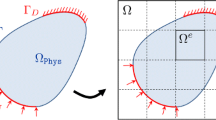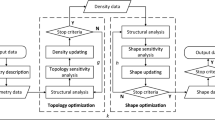Abstract
A method for shape optimization using Bézier triangles is introduced. The proposed procedure takes as input a CAD-compatible boundary representation of the domain and outputs an optimal design while maintaining an exact geometry representation at each iteration. The use of a triangular discretization allows the modeling of complex geometric domains, including voids, using a single patch. Some topology changes, such as those resulting from merging boundaries, can also be easily considered. An automatic mesh generator based on a quadtree construction is used to create the mesh. A gradient-based optimization algorithm (the method of moving asymptotes) is employed together with a sensitivity propagation procedure. We apply the method to some standard benchmark problems commonly considered in the literature and show that the proposed method converges to an optimal shape in only a few iterations.
















Similar content being viewed by others
References
Azegami H, Fukumoto S, Aoyama T (2013) Shape optimization of continua using NURBS as basis functions. Struct Multidiscip Optim 47(2):617–622
Bennett JA, Botkin ME (1985) Structural shape optimization with geometric description and adaptive mesh refinement. AIAA J 23(3):458–464
Bletzinger KU (1993) Extended method of moving asymptotes based on second-order information. Struct Optim 5(3):175–183
Buhl TC, Pedersen BW, Sigmund O (2000) Stiffness design of geometrically nonlinear structures using topology optimization. Struct Multidiscip Optim 19(2):93–104
Buhl T, Jensen FV, Pellegrino S (2004) Shape optimization of cover plates for retractable roof structures. Comput Struct 82(15–16):1227–1236
Cai S, Zhang W, Zhu J, Gao T (2014) Stress constrained shape and topology optimization with fixed mesh: a B-spline finite cell method combined with level set function. Comput Method Appl Mech Eng 278:361–387
Cho S, Ha SH (2008) Isogeometric shape design optimization: exact geometry and enhanced sensitivity. Struct Multidiscip Optim 38(1):53
De Leon DM, Alexandersen J, Fonseca JSO, Sigmund O (2015) Stress-constrained topology optimization for compliant mechanism design. Struct Multidiscip Optim 52(5):929–943
Ding Y (1986) Shape optimization of structures: a literature survey. Comput Struct 24(6):985–1004
Engvall L, Evans JA (2016) Isogeometric triangular Bernstein–Bézier discretizations: automatic mesh generation and geometrically exact finite element analysis. Comput Method Appl Mech Eng 304:378–407
Engvall L, Evans JA (2017) Isogeometric unstructured tetrahedral and mixed-element Bernstein–Bézier discretizations. Comput Method Appl Mech Eng 319:83–123
Engwirda D (2009) Mesh2d-automatic mesh generation. MatlabCentral: http://www.mathworks.com/matlabcentral/fileexchange/25555-mesh2d-automatic-mesh-generation
Farin G (2001) Curves and surfaces for CAGD: a practical guide, 5th edn. Morgan Kaufmann Publishers Inc., San Francisco
Fußeder D, Simeon B, Vuong A-V (2015) Fundamental aspects of shape optimization in the context of isogeometric analysis. Comput Method Appl Mech Eng 286:313–331
George PL, Borouchaki H (2012) Construction of tetrahedral meshes of degree two. Int J Numer Methods Eng 90(9):1156–1182
Ghasemi H, Brighenti R, Zhuang X, Muthu J, Rabczuk T (2015) Optimal fiber content and distribution in fiber-reinforced solids using a reliability and NURBS based sequential optimization approach. Struct Multidiscip Optim 51(1):99–112
Ghasemi H, Park HS, Rabczuk T (2017) A level-set based IGA formulation for topology optimization of flexoelectric materials. Comput Method Appl Mech Engrg 313:239–258
Goldman RN, Filip D (1987) Conversion from Bézier rectangles to Bézier triangles. Comput Aided Design 19(1):25–27
Guo X, Zhang W, Zhong W (2014) Doing topology optimization explicitly and geometrically—a new moving morphable components based framework. J Appl Mech 81(8):081009
Ha SH, Choi KK, Cho S (2010) Numerical method for shape optimization using T-spline based isogeometric method. Struct Multidiscip Optim 42(3):417–428
Haftka RT, Gürdal Z (2012) Elements of structural optimization, vol 11. Springer, Berlin
Hassani B, Khanzadi M, Tavakkoli SM (2012) An isogeometrical approach to structural topology optimization by optimality criteria. Struct Multidiscip Optim 45(2):223–233
Hojjat M, Stavropoulou E, Bletzinger KU (2014) The vertex morphing method for node-based shape optimization. Comput Method Appl Mech Eng 268:494–513
Hou W, Gai Y, Zhu X, Wang X, Zhao C, Xu L, Jiang K, Hu P (2017) Explicit isogeometric topology optimization using moving morphable components. Comput Method Appl Mech Eng 326:694–712
Hughes TJR, Cottrell JA, Bazilevs Y (2005) Isogeometric analysis: CAD, finite elements, NURBS, exact geometry and mesh refinement. Comput Method Appl Mech Eng 194(39–41):4135–4195
Jaxon N, Qian X (2014) Isogeometric analysis on triangulations. Comput Aided Design 46:45–57
Jia Y, Zhang Y, Xu G, Zhuang X, Rabczuk T (2013) Reproducing kernel triangular B-spline-based FEM for solving PDEs. Comput Method Appl Mech Eng 267:342–358
Kiendl J, Schmidt R, Wüchner R, Bletzinger K-U (2014) Isogeometric shape optimization of shells using semi-analytical sensitivity analysis and sensitivity weighting. Comput Method Appl Mech Eng 274:148–167
Le C, Norato J, Bruns T, Ha C, Tortorelli D (2010) Stress-based topology optimization for continua. Struct Multidiscip Optim 41(4):605–620
Lian H, Kerfriden P, Bordas S (2016) Implementation of regularized isogeometric boundary element methods for gradient-based shape optimization in two-dimensional linear elasticity. Int J Numer Methods Eng 106(12):972–1017
Lian H, Christiansen A, Tortorelli D, Sigmund O, Aage N (2017) Combined shape and topology optimization for minimization of maximal von Mises stress. Struct Multidiscip Optim 55(5):1541–1557
Lieu QX, Lee J (2019) An isogeometric multimesh design approach for size and shape optimization of multidirectional functionally graded plates. Comput Method Appl Mech Eng 343:407–437
Makky SM, Ghalib MA (1979) Design for minimum deflection. Eng Optimiz 4(1):9–13
Manh ND, Evgrafov A, Gersborg AR, Gravesen J (2011) Isogeometric shape optimization of vibrating membranes. Comput Method Appl Mech Eng 200(13–16):1343–1353
Meske R, Lauber B, Schnack E (2011) A new optimality criteria method for shape optimization of natural frequency problems. Struct Multidiscip Optim 31(4):295–310
Nagy AP, Abdalla MM, Gürdal Z (2010) Isogeometric sizing and shape optimisation of beam structures. Comput Method Appl Mech Eng 199(17–20):1216–1230
Nagy AP, Abdalla MM, Gürdal Z (2010) On the variational formulation of stress constraints in isogeometric design. Comput Method Appl Mech Eng 199(41–44):2687–2696
Nagy AP, Abdalla MM, Gürdal Z (2011) Isogeometric design of elastic arches for maximum fundamental frequency. Struct Multidiscip Optim 43(1):135–149
Nagy AP, IJsselmuiden ST, Abdalla MM (2013) Isogeometric design of anisotropic shells: optimal form and material distribution. Comput Method Appl Mech Eng 264(1):145–162
Nanthakumar SS, Valizadeh N, Park HS, Rabczuk T (2015) Surface effects on shape and topology optimization of nanostructures. Comput Mech 56(1):97–112
Nanthakumar SS, Lahmer T, Zhuang X, Park HS, Rabczuk T (2016) Topology optimization of piezoelectric nanostructures. J Mech Phys Solids 94:316–335
Nørtoft P, Gravesen J (2013) Isogeometric shape optimization in fluid mechanics. Struct Multidiscip Optim 48(5):909–925
Paris J, Navarrina F, Colominas I, Casteleiro M (2009) Topology optimization of continuum structures with local and global stress constraints mechanism design. Struct Multidiscip Optim 39(4):419–437
Picelli R, Townsend S, Brampton C, Norato J, Kim HA (2018) Stress-based shape and topology optimization with the level set method. Comput Method Appl Mech Eng 329:1–23
Piegl L, Tiller W (2012) The NURBS book, 2nd edn. Springer, Berlin
Qian X (2010) Full analytical sensitivities in NURBS based isogeometric shape optimization. Comput Method Appl Mech Eng 199(29–32):2059–2071
Qian X, Sigmund O (2011) Isogeometric shape optimization of photonic crystals via Coons patches. Comput Method Appl Mech Eng 200(25–28):2237–2255
Riehl S, Friederich J, Scherer M, Meske R, Steinmann P (2014) On the discrete variant of the traction method in parameter-free shape optimization. Comput Method Appl Mech Eng 278:119–144
Sigmund O (2001) A 99 line topology optimization code written in matlab. Struct Multidiscip Optim 21(2):120–127
Speleers H, Dierckx P, Vandewalle S (2006) Numerical solution of partial differential equations with Powell–Sabin splines. J Comput Appl Math 189(1–2):643–659
Speleers, Manni C (2015) Optimizing domain parameterization in isogeometric analysis based on Powell–Sabin splines. J Comput Appl Math 289:68–86
Speleers, Manni C, Pelosi F, Sampoli ML (2012) Isogeometric analysis with Powell–Sabin splines for advection–diffusion–reaction problems. Comput Method Appl Mech Eng 221–222:132–148
Svanberg K (1987) The method of moving asymptotes—a new method for structural optimization. Int J Numer Methods Eng 24(2):359–373
Svanberg K (2004) Some modelling aspects for the Matlab implementation of MMA. KTH Royal Institute of Technology, Stockholm
Valizadeh N, Rabczuk T (2019) Isogeometric analysis for phase-field models of geometric PDEs and high-order PDEs on stationary and evolving surfaces. Comput Method Appl Mech Eng 351:599–642
Wall WA, Frenzel MA, Cyron C (2008) Isogeometric structural shape optimization. Comput Method Appl Mech Eng 197(33–40):2976–2988
Wang C, Xia S, Wang X, Qian X (2018) Isogeometric shape optimization on triangulations. Comput Method Appl Mech Eng 331:585–622
Wang Y, Wang Z, Ia Z, Poh LH (2018) Structural design optimization using isogeometric analysis: a comprehensive review. Comput Model Eng Sci. https://doi.org/10.1002/nme.5593
Xia S, Qian X (2016) Isogeometric analysis with Bézier tetrahedra. Comput Method Appl Mech Eng 316:782–816
Xia S, Qian X (2018) Generating high-quality high-order parameterization for isogeometric analysis on triangulations. Comput Method Appl Mech Eng 338:1–26
Xia S, Wang X, Qian X (2015) Continuity and convergence in rational triangular Bézier spline based isogeometric analysis. Comput Method Appl Mech Eng 297:292–324
Xie X, Wang S, Xu M, Wang Y (2018) A new isogeometric topology optimization using moving morphable components based on R-functions and collocation schemes. Comput Method Appl Mech Eng 339:61–90
Yang RJ, Chen CJ (1996) Stress-based topology optimization. Struct Multidiscip Optim 12(2–3):98–105
Zeng S, Cohen E (2015) Hybrid volume completion with higher-order Bézier elements. Comput Aided Geom D 35–36:180–191
Zhang W, Yuan J, Zhang J, Guo X (2016) A new topology optimization approach based on Moving Morphable Components (MMC) and the ersatz material model. Struct Multidiscip Optim 53(6):1243–1260
Zhang W, Chen J, Zhu X, Zhou J, Xue D, Lei X, Guo X (2015) Explicit three dimensional topology optimization via Moving Morphable Void (MMV) approach. Comput Method Appl Mech Eng 322:590–614
Zhang W, Huang Q (2017) Unification of parametric and implicit methods for shape sensitivity analysis and optimization with fixed mesh. Int J Numer Methods Eng 109(3):326–344
Zhang W, Li D, Zhou J, Du Z, Li B, Guo X (2018) A Moving Morphable Void (MMV)-based explicit approach for topology optimization considering stress constraints. Comput Method Appl Mech Eng 334:381–413
Zhang W, Yang W, Zhou J, Li D, Guo X (2017) Structural topology optimization through explicit boundary evolution. J Appl Mech 84(1):011011
Zhang W, Zhao L, Cai S (2015) Shape optimization of Dirichlet boundaries based on weighted B-spline finite cell method and level-set function. Comput Method Appl Mech Eng 294:359–383
Acknowledgements
The authors extend their appreciation to the Distinguished Scientist Fellowship Program (DSFP) at King Saud University for funding this work.
Author information
Authors and Affiliations
Corresponding author
Additional information
Publisher's Note
Springer Nature remains neutral with regard to jurisdictional claims in published maps and institutional affiliations.
Rights and permissions
About this article
Cite this article
López, J., Anitescu, C., Valizadeh, N. et al. Structural shape optimization using Bézier triangles and a CAD-compatible boundary representation. Engineering with Computers 36, 1657–1672 (2020). https://doi.org/10.1007/s00366-019-00788-z
Received:
Accepted:
Published:
Issue Date:
DOI: https://doi.org/10.1007/s00366-019-00788-z




